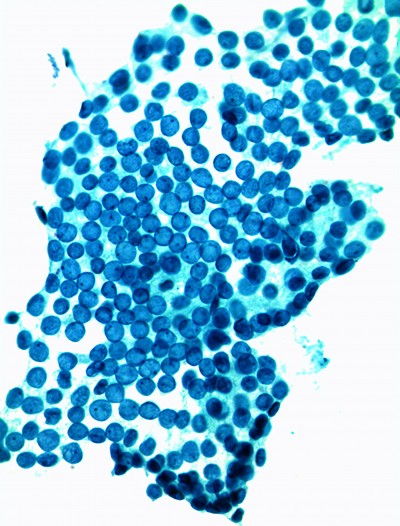News & Publications
Diagnosis of Blastic Plasmacytoid Dendritic Cell Neoplasm
January 1, 2014
By Ayumi Corn, M.D.
Neoplastic infiltrates of the skin with blastoid morphology can be diagnostically challenging. When evaluating such lesions, hematolymphoid neoplasms are a primary consideration, and immunohistochemical studies are frequently performed to determine the lineage of the neoplastic cells. The histologic differential diagnosis includes B-cell and T-cell lymphomas, NK-cell neoplasms, high grade plasma cell neoplasms, myeloid leukemia cutis, and blastic plasmacytoid dendritic cell neoplasm.
Most cases of B-cell, T-cell, NK-cell, and plasma cell neoplasms have a specific immunophenotype that can be established by immunohistochemical evaluation. After these entities are excluded, the differential diagnosis is most frequently between a cutaneous presentation of acute myeloid leukemia (leukemia cutis) and blastic plasmacytoid dendritic cell neoplasm. These two neoplastic processes can be difficult to distinguish due to overlap of both morphologic, immunophenotypic, and clinical features.
Acute myeloid leukemia typically presents with peripheral blood and bone marrow involvement, but may occasionally involve extramedullary tissue. A tumor mass of myeloid blasts in tissue outside of the bone marrow (myeloid sarcoma) can occur in essentially any body site, including skin, soft tissue, lymph nodes, and gastrointestinal tract. In cases of acute myeloid leukemia with skin involvement (or leukemia cutis), the finding of characteristic blasts in the peripheral blood and bone marrow, with the support for flow cytometric immunophenotyping, may be diagnostic. Past medical history may be very enlightening in a subset of these cases. A patient with a previous diagnosis of acute myeloid leukemia and subsequently presenting with skin lesions mostly likely has leukemia cutis. Cases with involvement limited to the skin and in which the patient has no prior history, however, can be more diagnostically challenging.
Blastic plasmacytoid dendritic cell neoplasm is an aggressive tumor believed to be derived from precursors of plasmacytoid dendritic cells. Patients with this neoplasm present with solitary or multiple skin lesions, and peripheral blood and bone marrow involvement usually occur later in disease progression. Distinguishing blastic plasmacytoid dendritic cell neoplasm from leukemia cutis in skin biopsies requires immunophenotypic studies, but there is significant overlap in immunophenotype, including positivity for CD4, CD33, CD43, CD56, CD68, HLA-DR.
CD123 and TCL-1 have been shown to be expressed by blastic plasmacytoid dendritic cell neoplasms, and when included in the immunohistochemical panel, may be useful in its distinction from leukemia cutis. TCL-1 has been reported to be positive in 82-90% of blastic plasmacytoid dendritic cell neoplasms, whereas only 7-17% of leukemia cutis are positive. The addition of CD123 to the immunohistochemical panel is helpful given that 83%-100% of blastic plasmacytoid dendritic cell neoplasms have been reported to be positive for CD123, while only 17% of leukemia cutis are positive. In the correct clinical setting, positivity for CD4, CD56, CD123, and TCL-1 in a morphologically blastoid population supports the diagnosis of blastic plasmacytoid dendritic cell neoplasm.
References
Swerdlow SH, Campo E, Harris HL, et al, eds. WHO Classification of Tumours of Haematoopoietic and Lymphoid Tissues. 4th ed. Lyon, France:IARC Press; 2008:145-147.
Cronin DMP, George TI, Reichard KK, Sundram UN. Immunophenotypic analysis of myeloperoxidase-negative leukemia cutis and blastic plasmacytoid dendritic cell neoplasm. Am J Clin Pathol 2012;137:367-376.
Feuillard J, Jacob MC, Valensi F, et al. Clinical and biologic features of CD4+ CD56+ malignancies. Blood. 2002;999:1556-1563.
Herling M, Teitell MA, Shen RR, et al. TCL1 expression in plasmacytoid dendritic cells (DC2s) and the related CD4+ CD56+ blastic tumors of skin. Blood. 2003;101:5007-5009.
Petrella T, Comeau MR, Maynadie M, et al. ‘Agranular CD4+ C56+ hematodermic neoplasm’ (blastic NK-cell lymphoma) originates from a population of CD56+ precursor cells related to plasmacytoid monocytes. Am J Surg Pathol. 2002;26:852-862.
Petrella T, Meijer CJ, Dalac S, et al. TCL1 and CLA expression agranular CD4/CD56 hematodermic neoplasms (blastic NK-cell lymphomas) and leukemia cutis. Am J Clin Pathol. 2004;12:307-313.
Reichard KK, Burks EJ, Foucar MK, et al. CD4+ CD56+ lineage-negative malignancies are rare tumors of plasmacytoid dendritic cells. Am J Surg Pathol. 2005;29:1274-1283.
